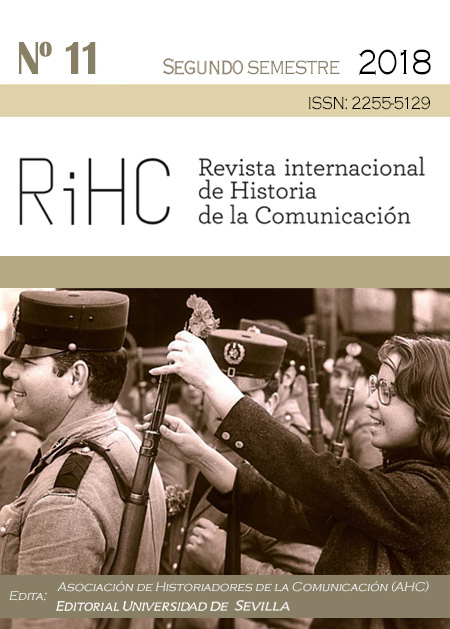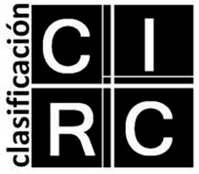Ethno-iconographic Vogue’s editorials (1948-2016): an approach to cultural diplomacies
DOI:
https://doi.org/10.12795/RiHC.2018.i11.09Keywords:
Fashion magazines, photography, ethnography, cultural studies, cultural diplomacy.Abstract
This article offers an overview of a seminal research that has laid its foundations in a systematization of the messages emerging from the interface between different cultures through fashion communication and image making. It delves into a semantic study on the variety of compositions related to ethno-iconography that have been developed by western editions of Vogue since 1948. In parallel, it examines the continuity of their visual discourses by recent non-western editions. It explores the relation between the functions of the fashion magazines per se, and those of the travel magazines, ethnographic photography and even documentary photojournalism. From this interpretative framework, the study assess the potential of fashion magazine as an instrument that provides visibility to social realities and that acts as triggers of critical reflection and agents capable of establishing inter-cultural relations.
Downloads
References
ADAM, I. and H. TIFFIN (eds.) (1991): Past the Last Post: Theorizing Post-Colonialism and Post-Modernism. New York: Harvester Wheatsheaf, p. vii.
BARLETT, D., (2006): “In Russia, At Last and Forever: The First Seven Years of Russian Vogue,” in Fashion Theory Journal, Vol. 10, no. 1&2, 2006, pp. 175-204.
CHEANG, S., (2013): “’To the Ends of the Earth’. Fashion and Ethnicity in Vogue Fashion Shoot,” in Bartlett D., Cole, S. and Rocamora, A. (editors), Fashion Media: Past and Present, London, Berg, pp. 35-45.
CRAIK, J., (1994): The Face of Fashion: Cultural Studies in Fashion. London: Routledge.
DEFERT, D., (1989): “Un género etnográfico profano en el siglo XVI: los libros de trajes (ensayo de etno-iconografía),” in RUPP-EISENREICH B. (editor), Historias de la Antropología (siglos XVI-XIX), Madrid, Ediciones Júcar, pp. 24-38.
DESERPS, F., (1567): Recueil de la diversité des habits, qui sont de présent en usage, tant es pays d'Europe, Asie, Affrique & isles sauvages, le tout fait après le natural. Paris: Imprimerie de Richard Breton. doi: ark:/12148/bpt6k102756w.
GIENOW-HECHT, J. C. E. and DONFRIED, M. C. (2013): Searching for a Cultural Diplomacy. New York, Berghahn.
HWAJUNG, K., (2011): “Cultural Diplomacy as the Means of Soft Power in an Information Age.” Online (April, 2018)
JOHNSON, W. (1866): The oriental races and tribes, residents and visitors of Bombay: a series of photographs with letter-press descriptions, London, Bolton and Barnitt.
JONES, A. R., (2006): “Habits, Holdings, Heterologies: Populations in Print in a 1562 Costume Book,” in Burland M., LaGuardia, D. and Tarnowski, A. (editors), Meaning and Its Objects: Material Culture in Medieval and Renaissance France, New Haven, Yale University Press, pp. 92-121.
JORA, L., (2013) “New Practices and Trends in Cultural Diplomacy,” in Romanian Review of Political Sciences and International Relations 10, no. 1, 2013. Online (April, 2018): http://journal.ispri.ro/wp-content/uploads/2013/03/43-52-Lucian-Jora.pdf
LUTHER, N. and DEEN DAYAL, R. (2003): Raja Deen Dayal: Prince of Photographers, Hyderabad, Hyderabad in.
MENÉNDEZ MENÉNDEZ, M. I., (2009): “Aproximación teórica al concepto de prensa femenina,” in Comunicación y Sociedad, Vol. XXII. no. 2, 2009, pp. 27-34.
PENN, I., (1974): Worlds in a Small Room, New York, Grossman Publishers.
PUDDICK, M. and PRIYA, M., (2012): “Contemporary Luxury,” in
ATWAL G. and JAIN S. (editors), The Luxury Market in India: Maharajas to Masses, New York, Palgrave Macmillan.
SANDHU, A., (2015): Indian Fashion: Tradition, Innovation, Style, London/New York, Bloomsbury.
THEUWS, M. and OVEREEM, P., (2014): Flawed Fabrics. The abuse of girls and women workers in the South Indian textile industry, Amsterdam/Utrecht, Centre for Research on Multinational Corporations and Indian Comitee of the Netherlands.
TIMMONS, H., (2008): “Vogue’s Fashion Photos Spark Debate in India,” The New York Times. Online (April, 2018): (http://www.nytimes.com/2008/09/01/business/worldbusiness/01vogue.html?_r=0
ZORACH, R., (2005): Blood, Milk, Ink, Gold: Abundance and Excess in the French Renaissance, Chicago, The Univer
Downloads
Published
How to Cite
Issue
Section
License
RiHC. Revista internacional de Historia de la Comunicación is an open access publication, offering its content under the principle that making research available to the public free of charge contributes to the greater exchange of global knowledge.
RiHC. Revista internacional de Historia de la Comunicación adheres to the various initiatives that promote access to knowledge. All content is therefore free of charge and is published under the Creative Commons Attribution-NonCommercial-ShareAlike 4.0 International license.
By virtue of this, the authors who publish in this journal accept the following conditions:
- Open access content may be freely shared (that is, copied and redistributed in any medium or format) and adapted (remixed, transformed and built upon).
- Attribution: The user of the content must give appropriate credit, provide a link to the license, and indicate if changes were made. This may be done in any reasonable manner, but not in any way that suggests the licensor endorses the user or their use.
- Non Commercial: The content may not be used for any commercial purpose.
- Share Alike: If the content is remixed, transformed or built upon, it must be distributed under the same licence as the original.
- No additional restrictions: No legal terms or technological measures may be applied that legally restrict others from doing anything the licence permits.













